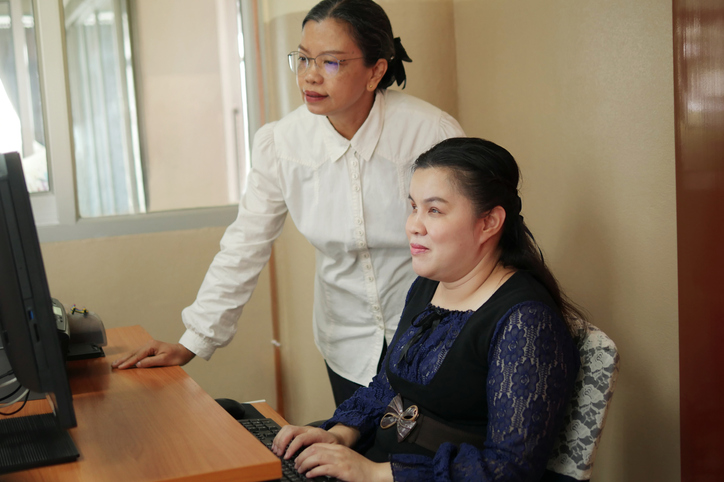Many people have the perception that being blind means total blindness and that it has been since birth. However, the reality is that vision loss covers a broad array of visual disability and can happen to any person at any stage of life.
Today, there are over 1.5 million Canadians living with sight loss and an estimated 5.59 million have an eye disease that could cause sight loss. According to the Canadian National Institute for the Blind’s (CNIB) International Levels of Employment Study, the national unemployment rate of Canadians living with sight loss is 16%.
With the progression of inclusive hiring, there are more opportunities being created in the labour market for individuals with disabilities. However, the path for returning to employment for those with sight loss presents it challenges and unique hurdles to entering (or re-entering) the workforce.
Navigating barriers to employment
Grief and loss
Losing your sight is a traumatic event. There is a grief cycle that many individuals not only work through, but that may resurface at different points of the jobseeking journey. Examples of this may include: going for a job interview and experiencing rejection, inability or lack of confidence in disability disclosure, and/or losing employment due to inability to keep up with job functions. Many jobseekers have been independent their whole lives, which can make reaching out for support or assistance even more challenging.
It is important to approach your client with open discussion surrounding their disability and meet them where they are at. Be mindful to walk alongside your client and ensure that they have sufficient support in their life. This can come in the form of counselling, peer support groups or connecting with friends/family to encourage safe disclosure.
Career direction
Often, individuals who have experienced sight loss suddenly and are unable to return to their previous occupation will ask, “What can I do for work with my visual impairment?” In turn, individuals may attempt to job search solely on what they believe they can do (or the limiting beliefs of what can be done), rather than finding work that is meaningful to them. This perspective can often present challenges because if employment opportunities are pursued that the jobseeker is not invested in, they are not setting themselves up for long-term success. This approach can result in feelings of failure, leading to setbacks.
As career practitioners, it might be tempting to advise on appropriate career choices, but it’s important to remember that our primary role is to guide and support our clients by carefully leading them through the career exploration process. Career professionals are encouraged to use self-discovery workshops, vocational assessments or other tools that you would provide to any other client. Client-centred career exploration processes are imperative to fostering client autonomy in career decision-making, which assists individuals with seeing beyond their vision loss and building skills conducive to their success.
“… individuals may attempt to job search solely on what they believe they can do (or the limiting beliefs of what can be done), rather than finding work that is meaningful to them.”
Assistive technology
Once the individual has decided on a career direction, the next barrier is often determining how to get the job done and perform optimally. This is where assistive technology comes into play and acts as the catalyst to employment. Assistive technology is about making computers and smartphones accessible to someone who is blind or partially sighted. Computer software such as: JAWS, NVDIA (screen readers) and ZoomText (screen magnification) or existing built-in accessibility features like Voiceover on iOS, TalkBACK on Android or other magnification settings are examples of what is used in the workplace.
Jobseekers with sight loss need to be aware of and proficient in assistive technologies to be competitive in the labour market. Career professionals should support clients in understanding their assistive technology needs relative to their current level of vision. This can be accomplished with a referral to a vocational rehabilitation worker, connecting with the CNIB, and/or with Vision Loss Rehabilitation Canada.
Finally, after obtaining assistive technology, the practitioner should ensure that the individual has had enough computer skills training and/or education to confidently return to the labour market. Proficiency in skills translates to confidence in applying for work.

Service delivery tips
If you have a meeting scheduled with a client who has vision loss, ensure the following:
- Use descriptive language for directions (e.g. how to get to the meeting room, the layout of the room)
- Ask if there is a preferred document format (word, pdf, excel, braille, etc.) for access to any referenced documents in advance
- Avoid asking questions about how the person lost their vision unless they wish to disclose
- Feel comfortable to use terms such as “see” and “look” as they are part of everyday language
- Always identify yourself by name including in virtual meetings
Come to Work with CNIB’s support
If you are working with an individual experiencing sight loss, CNIB’s Come to Work program will work in collaboration with vocational partners to provide the following supports and services:
- Customized program plans relating to sight loss
- Access to rehabilitation services such as orientation and mobility through Vision Loss Rehabilitation Canada
- Assistive Technology awareness and basic training
- Job-readiness workshops
- Professional development through innovative mentorships
- Job retention support
- Self-employment programming
- Networking events with inclusive employers through partnerships for employment opportunities
Conclusion
Returning to the labour market due to a career change can be challenging for anyone, even more so with the complexities of sight loss. For the visually impaired jobseeker, having the opportunity to see themselves beyond their vision loss will be a pivotal point in their jobseeking and return-to-work journey. Understanding the barriers above is the first step to providing optimal service to the vison loss community.




